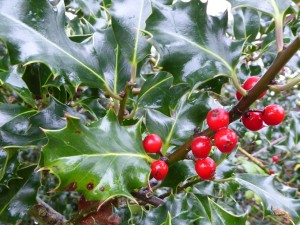Holly is well known and loved for its spiky evergreen leaves and bright red berries, and as a symbol of Christmas. In homage to the twelve days of Christmas, here’s twelve fascinating holly facts and activities that you can use on an outdoor walk or lesson.
- Common holly (Ilex aquifolium) has long been regarded as a plant of good omen as its shiny evergreen leaves and red berries symbolise life in the midst of winter. The druids believed that the sun would never forsake the holly tree and would bring its greenery into their homes to lift their spirits during mid-winter festivities.
- Holly brought into dwellings was also believed to help shelter and protect elves and faeries. However, all the green foliage had to be removed by Imbolic Eve (January 31st) for any leaf remaining would bring misfortune! In later years this custom became the Twelfth Night (5th January) which is why we take down Christmas decorations by this date.
- In the New Forest holly is still traditionally cut above the reach of animals called pollarding. This management extends the life of the holly tree and the cut foliage provide an important food source for New Forest ponies in the winter. They often wait for the cut holly to wilt before eating – much more palatable!
- A trip to the New Forest will also reveal how holly bark is eaten by ponies and deer. The scarred trunks of the holly trees make them look old and gnarly. A group of holly trees, called a holly holm, makes a good setting to talk about goblins and woodland faeries. Make your own tree spirits with fallen twigs and leaves which can hide amongst the trees.
- Time for a story – there are many tales about the Green Man of the summer (Oak King) who turns into the Holly King at the Winter Solstice. Using the story’s imagery groups can create the Green Man’s face on a tree trunk using mud and natural materials found on the ground.
- In Medieval England holly was used to construct a ‘Holy Bough’. Make your own by twisting cut willow into a double hoop and decorate with holly and evergreens. Hung on a door visitors would embrace as a gesture of good well. Also believed to ward off pesky goblins.
- Holly blooms between May and August, with clusters of small white star-like flowers. Only the female trees have the bright red berries that appear in September.
- According to folklore, this year’s bumper crop of berries warns of a hard winter on the way. However this is really the result of a good summer – look for birds such as larks and field-fares greedily eating the fruit. After a frost the fruits soften and are more palatable to birds. Pull apart a squishy berry to find the four little fruit stones inside – please note that holly seeds are poisonous to humans.
- Look for prickly ‘he-holly’ and less spiny ‘she-holly’. Leaves are lobed, with each lobe ending in a sharp spine. Ask the group to find a leaf with the largest number of prickles? Collected leaves can be stuck onto a strip of card with double sided sticky tape in ascending number of prickles or made into a holly crown.
- Leaves on trees over 3 metres are often less prickly as the tree does not need to protect itself from grazing animals. See if the group can work this out!
- Holly leaves fall off the plant after three to four years and take a long time to decay. Often leaf skeletons can be found on the ground beneath the trees. Try and find some to study the beautiful vein structures.
- Caterpillars of the Holly Blue butterfly feed on holly flower buds in the spring.

